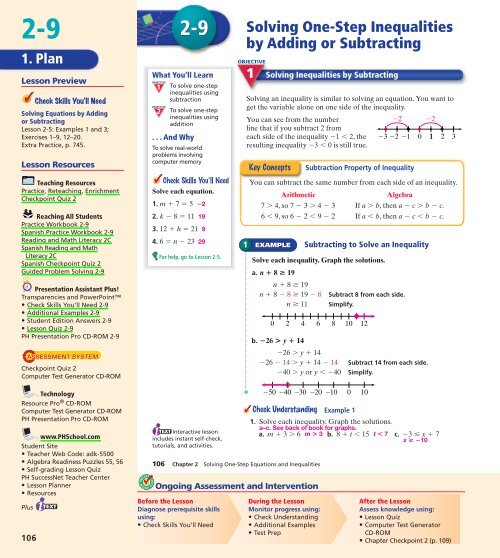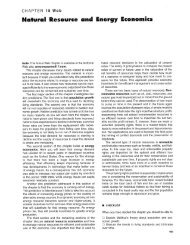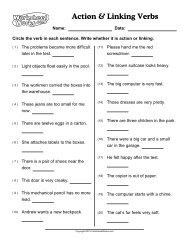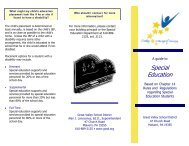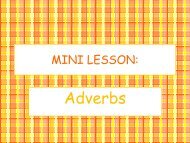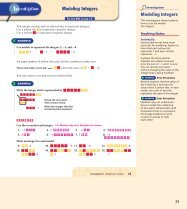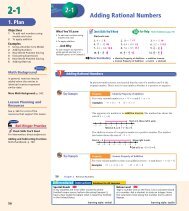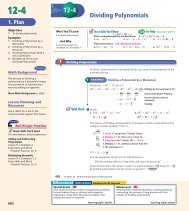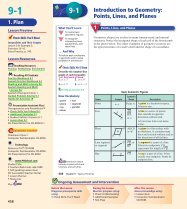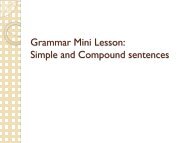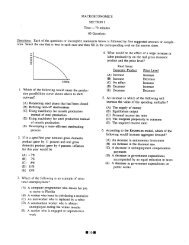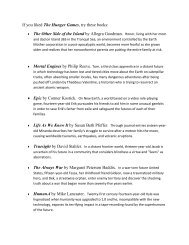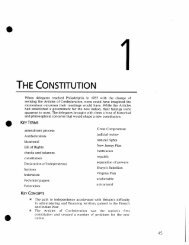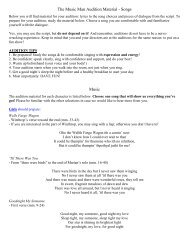Pre Alg TE Lesson 2-9
Pre Alg TE Lesson 2-9
Pre Alg TE Lesson 2-9
Create successful ePaper yourself
Turn your PDF publications into a flip-book with our unique Google optimized e-Paper software.
2-9<br />
1. Plan<br />
<strong>Lesson</strong> <strong>Pre</strong>view<br />
Check Skills You'll Need<br />
Solving Equations by Adding<br />
or Subtracting<br />
<strong>Lesson</strong> 2-5: Examples 1 and 3;<br />
Exercises 1–9, 12–20.<br />
Extra Practice, p. 745.<br />
<strong>Lesson</strong> Resources<br />
Teaching Resources<br />
Practice, Reteaching, Enrichment<br />
Checkpoint Quiz 2<br />
Reaching All Students<br />
Practice Workbook 2-9<br />
Spanish Practice Workbook 2-9<br />
Reading and Math Literacy 2C<br />
Spanish Reading and Math<br />
Literacy 2C<br />
Spanish Checkpoint Quiz 2<br />
Guided Problem Solving 2-9<br />
<strong>Pre</strong>sentation Assistant Plus!<br />
Transparencies and PowerPoint<br />
• Check Skills You'll Need 2-9<br />
• Additional Examples 2-9<br />
• Student Edition Answers 2-9<br />
• <strong>Lesson</strong> Quiz 2-9<br />
PH <strong>Pre</strong>sentation Pro CD-ROM 2-9<br />
ASSESSMENT SYS<strong>TE</strong>M<br />
Checkpoint Quiz 2<br />
Computer Test Generator CD-ROM<br />
2-9<br />
What You’ll Learn<br />
OBJECTIVE<br />
1<br />
OBJECTIVE<br />
2<br />
To solve one-step<br />
inequalities using<br />
subtraction<br />
To solve one-step<br />
inequalities using<br />
addition<br />
. . . And Why<br />
To solve real-world<br />
problems involving<br />
computer memory<br />
Check Skills You’ll Need<br />
Solve each equation.<br />
1. m + 7 = 5 –2<br />
2. k - 8 = 11 19<br />
3. 12 + h = 21 9<br />
4. 6 = n - 23 29<br />
For help, go to <strong>Lesson</strong> 2-5.<br />
Solving One-Step Inequalities<br />
by Adding or Subtracting<br />
OBJECTIVE<br />
1 Solving Inequalities by Subtracting<br />
Solving an inequality is similar to solving an equation. You want to<br />
get the variable alone on one side of the inequality.<br />
You can see from the number<br />
line that if you subtract 2 from<br />
each side of the inequality -1 , 2, the<br />
resulting inequality -3 , 0 is still true.<br />
2<br />
3 2 1 0<br />
2<br />
1 2 3<br />
1<br />
Key Concepts<br />
Subtraction Property of Inequality<br />
You can subtract the same number from each side of an inequality.<br />
Arithmetic<br />
7 . 4, so 7 - 3 . 4 - 3<br />
6 , 9, so 6 - 2 , 9 - 2<br />
EXAMPLE<br />
Subtracting to Solve an Inequality<br />
Solve each inequality. Graph the solutions.<br />
a. n ± 8 L 19<br />
n + 8 $ 19<br />
n + 8 - 8 $ 19 - 8<br />
n $ 11<br />
Subtract 8 from each side.<br />
Simplify.<br />
0 2 4 6 8 10 12<br />
<strong>Alg</strong>ebra<br />
If a . b, then a - c . b - c.<br />
If a , b, then a - c , b - c.<br />
b. –26 S y ± 14<br />
-26 . y + 14<br />
-26 - 14 . y + 14 - 14 Subtract 14 from each side.<br />
-40 . y or y , -40 Simplify.<br />
Technology<br />
Resource Pro ® CD-ROM<br />
Computer Test Generator CD-ROM<br />
PH <strong>Pre</strong>sentation Pro CD-ROM<br />
www.PHSchool.com<br />
Student Site<br />
• Teacher Web Code: adk-5500<br />
• <strong>Alg</strong>ebra Readiness Puzzles 55, 56<br />
• Self-grading <strong>Lesson</strong> Quiz<br />
PH SuccessNet Teacher Center<br />
• <strong>Lesson</strong> Planner<br />
• Resources<br />
Plus<br />
106<br />
INSTANT<br />
CHECK SYS<strong>TE</strong>M<br />
Interactive lesson<br />
includes instant self-check,<br />
tutorials, and activities.<br />
50 40 30 20 10 0 10<br />
106 Chapter 2 Solving One-Step Equations and Inequalities<br />
Ongoing Assessment and Intervention<br />
Before the <strong>Lesson</strong><br />
Diagnose prerequisite skills<br />
using:<br />
• Check Skills You’ll Need<br />
Check Understanding Example 1<br />
1. Solve each inequality. Graph the solutions.<br />
a–c. See back of book for graphs.<br />
a. m + 3 . 6 m S 3 b. 8 + t , 15 t R 7 c. -3 # x + 7<br />
x L–10<br />
During the <strong>Lesson</strong><br />
Monitor progress using:<br />
• Check Understanding<br />
• Additional Examples<br />
• Test <strong>Pre</strong>p<br />
After the <strong>Lesson</strong><br />
Assess knowledge using:<br />
• <strong>Lesson</strong> Quiz<br />
• Computer Test Generator<br />
CD-ROM<br />
• Chapter Checkpoint 2 (p. 109)
2<br />
EXAMPLE<br />
Real-World<br />
Problem Solving<br />
2. Teach<br />
Computers Nearly 32 megabytes (MB) of memory are available<br />
for running your computer. If its basic systems require 12 MB,<br />
how much memory is available for other programs?<br />
Words memory for plus memory for is less<br />
basic systems other programs than<br />
Let m = memory available for other programs.<br />
Inequality 12 + m<br />
, 32<br />
12 + m , 32<br />
12 - 12 + m , 32 - 12 Subtract 12 from each side.<br />
m , 20 Simplify.<br />
Less than 20 MB of memory is available for other programs.<br />
Check Understanding Example 2<br />
2. An airline lets you check up to 65 lb of luggage. One suitcase<br />
weighs 37 lb. How much can another suitcase weigh? K 28 lb<br />
OBJECTIVE<br />
3<br />
2<br />
Using Addition to Solve Inequalities<br />
To solve an inequality involving subtraction, use addition.<br />
Key Concepts<br />
Addition Property of Inequality<br />
You can add the same number to each side of an inequality.<br />
Arithmetic<br />
7 . 3, so 7 + 4 . 3 + 4<br />
2 , 5, so 2 + 6 , 5 + 6<br />
EXAMPLE<br />
Solve n – 15 R 3.<br />
n - 15 , 3<br />
n - 15 + 15 , 3 + 15<br />
n , 18<br />
Check Understanding Example 3<br />
3. Solve each inequality.<br />
<strong>Alg</strong>ebra<br />
If a . b, then a + c . b + c.<br />
If a , b, then a + c , b + c.<br />
Adding to Solve an Inequality<br />
Add 15 to each side.<br />
Simplify.<br />
a. m - 13 . 29 b. v - 4 # 7 c. t - 5 $ 11<br />
m S 42 v K 11 t L 16<br />
total<br />
memory<br />
1 A B C D E<br />
2 A B C D E<br />
3 A B C D E<br />
4 A B C D E<br />
5 A B C D E<br />
B C D E<br />
Test-Taking Tip<br />
To check that n , 18<br />
is a solution of<br />
n - 15 , 3, use related<br />
equations n = 18 and<br />
n - 15 = 3. Substitute<br />
18 into n - 15 = 3 and<br />
get 18 - 15 = 3. The<br />
result suggests that you<br />
solved correctly.<br />
2-9 Solving One-Step Inequalities by Adding or Subtracting 107<br />
Math Background<br />
The same number can be added<br />
to or subtracted from each side of<br />
an inequality to get a new<br />
inequality with the same solutions<br />
as the original.<br />
Teaching Notes<br />
1<br />
Error <strong>Pre</strong>vention<br />
Point out that to rewrite an<br />
inequality in reverse order, you<br />
must pay attention to the<br />
direction of the inequality symbol.<br />
You rewrite 5 . x as x , 5,<br />
changing . to ,. Have students<br />
write an inequality for Kyle is<br />
older than Jaime in two ways.<br />
Kyle’s age > Jaime’s age;<br />
Jaime’s age < Kyle’s age<br />
2<br />
Diversity<br />
Some students may be unfamiliar<br />
with computer terminology.<br />
Explain that a byte is a unit of<br />
computer memory that stores a<br />
single character. Explain to<br />
students that the prefix mega<br />
means one million. Ask students<br />
to guess what 1 megabyte might<br />
mean. one million bytes<br />
1<br />
2<br />
3<br />
EXAMPLE<br />
EXAMPLE<br />
PowerPoint<br />
Additional Examples<br />
Solve each inequality. Graph<br />
the solutions.<br />
a. 4 + s , 12 s R 8<br />
b. -16 $ y - 14<br />
–2 L y or y K–2<br />
See back of book for graphs.<br />
Suppose your computer’s hard<br />
drive has a capacity of 6<br />
gigabytes (GB). The files you<br />
have stored on the hard drive<br />
occupy at least 2 GB. How<br />
much storage space is left for<br />
other files? s K 4; at most<br />
4 GB are left.<br />
Solve -10 , -13 + q. 3 R q<br />
Reaching All Students<br />
Closure<br />
Below Level Ask: What do you do to<br />
each side of the equation to get the<br />
variable alone for d + 5 = 9?<br />
Subtract 5. For f - 6 = 4? Add 6.<br />
Advanced Learners Ask: If you try<br />
to list all the solutions for x > 1,<br />
which number would you list first?<br />
Explain. Answers may vary.<br />
Sample: 2; because it’s the first<br />
integer greater than 1.<br />
Error <strong>Pre</strong>vention<br />
See note on page 107.<br />
Diversity<br />
See note on page 107.<br />
Ask students to compare solving<br />
inequalities involving addition<br />
and subtraction with solving<br />
equations involving addition and<br />
subtraction. See back of book.<br />
107
3. Practice<br />
Assignment Guide<br />
1 Objective 1<br />
A B Core 1–10, 20, 23,<br />
28, 29, 31–34<br />
C Extension 35, 37<br />
2 Objective 2<br />
A B Core 11–19, 21, 22,<br />
24–27, 30<br />
C Extension 36<br />
Test <strong>Pre</strong>p 38–40<br />
Mixed Review 41–47<br />
108<br />
Practice 2-9<br />
Solving One-Step Inequalities by<br />
Adding or Subtracting<br />
Write an inequality for each sentence. Then solve the inequality.<br />
1. Six less than n is less than 4.<br />
n 2 6 * 4; n * 2<br />
2. The sum of a number k and five is greater than or equal to two.<br />
k 1 5 # 2; k # 3<br />
3. Nine more than a number b is greater than negative three.<br />
b 1 9 + 3; b + 12<br />
4. You must be at least 48 inches tall to ride an amusement park ride, and<br />
your little sister is 39 inches tall. How many inches i must she grow<br />
before she may ride the ride?<br />
39 1 i # 48; i # 9<br />
5. You need no more than 3,000 calories in a day. You consumed 840<br />
calories at breakfast and 1,150 calories at lunch. How many calories c<br />
can you eat for dinner?<br />
840 1 1,150 1 c " 3,000; c " 1,010<br />
Solve each inequality. Graph the solutions.<br />
6. 7 1 x $ 9 x # 2<br />
7. 25 # x 2 6<br />
5 4 3 2 1<br />
8. 0 $ x 1 12 x " 12<br />
9.<br />
16<br />
12<br />
8<br />
10. 13 1 x $ 13 x # 0 11.<br />
5 4 3 2 1<br />
12. 4 1 x ,22 x * 6 13.<br />
8 7 6 5 4<br />
14. x 2 6 #21 x " 5<br />
15.<br />
5 4 3 2 1<br />
0 1 2 3 4 5<br />
4 0 4<br />
0 1 2 3 4 5<br />
3 21 0 1 2<br />
0 1 2 3 4 5<br />
5 4 3 2 1<br />
x 2 15 #28<br />
2 1<br />
0<br />
x 2 8 .25<br />
5 4 3 2 1<br />
x 2 9 .211<br />
1 2<br />
5 4 3 2 1<br />
24 1 x ,24<br />
5 4 3 2 1<br />
x # 1<br />
0 1 2 3 4 5<br />
x " 7<br />
3 4 5 6 7 8<br />
x + 3<br />
0 1 2 3 4 5<br />
x + 2<br />
0 1 2 3 4 5<br />
x * 0<br />
0 1 2 3 4 5<br />
Solve each inequality. Then write the letter matching the solution in the key<br />
on the line to the left of the problem number. The result will be something<br />
fun to do.<br />
H 1. x 1 2 , 13 x * 11<br />
Key<br />
A 2.<br />
x " 4<br />
A x #24<br />
x 2 1 #25<br />
D x , 3<br />
V 3. 15 , x 1 17 x + 2<br />
E x . 3<br />
H x , 11<br />
E 4. x 2 9 .26 x + 3<br />
I x $ 9<br />
M x # 9<br />
N x ,23<br />
P x $ 2<br />
A 5. 26 $ x 2 2 x " 4<br />
R x , 5<br />
S x $24<br />
T x $25<br />
P 6. x 2 12 $210 x # 2<br />
U x . 1<br />
V x .22<br />
I 7. x 2 5 $ 4 x # 9<br />
Y x #22<br />
Z 8. x 1 2 . 6 x + 4<br />
Z x . 4<br />
Z 9. 25 , x 2 9 x + 4<br />
A 10. 3 $ x 1 7 x " 4<br />
P<br />
A<br />
R<br />
T<br />
Y<br />
Enrichment 2-9<br />
11. 26 # x 2 8 x # 2<br />
12. x 1 8 # 4 x " 4<br />
13. 2 1 x , 7 x * 5<br />
14. 4 # x 1 9 x # 5<br />
15. 25 $ x 2 3 x " 2<br />
Having Fun<br />
Practice<br />
Enrichment<br />
EXERCISES<br />
Practice and Problem Solving<br />
A<br />
B<br />
Practice by Example<br />
Example 1<br />
(page 106)<br />
Example 2<br />
(page 107)<br />
Example 3<br />
(page 107)<br />
Apply Your Skills<br />
35. Comm. Prop. of Add.<br />
Simplify.<br />
Subt. Prop. of<br />
Inequality<br />
Simplify.<br />
36. Subt. within<br />
parentheses.<br />
Simplify.<br />
Add. Prop. of Inequality<br />
Simplify.<br />
C<br />
Challenge<br />
108 Chapter 2 Solving One-Step Equations and Inequalities<br />
GPS<br />
22.<br />
Use the Guided Problem<br />
Solving worksheet with<br />
Exercise 10.<br />
0 2 6<br />
Solve each inequality. Graph the solutions.<br />
1–8. See back of book for graphs.<br />
1. w + 5 , 12 2. 2 . 9 + a 3. x + 6 $ 7 4. 2 + m # 2<br />
w R 7 a R–7 x L 1 m K 0<br />
5. 18 # 20 + w 6. -7 , 5 + x 7. 30 $ t + 45 8. p + 22 $ -10<br />
w L–2 x S–12 t K–15 p L–32<br />
9. Transportation The total weight limit for a truck is 100,000 lb. The<br />
truck weighs 36,000 lb empty. What is the most that the truck’s<br />
load can weigh? 64,000 lb<br />
10. Budgeting You are saving to buy a bicycle that will cost at least<br />
GPS<br />
$120. Your parents give you $45 toward the bicycle. How much<br />
money will you have to save?<br />
L $75<br />
Solve each inequality.<br />
11. x - 5 $ 6 12. n - 12 # 3 13. r - 4 # 3<br />
x L 11<br />
n K 15 r K 7<br />
14. x - 7 , 15 15. c - 9 . 5 16. h - 10 $ 6<br />
x R 22<br />
c S 14 h L 16<br />
17. w - 8 , 3 18. 12 $ y - 5 19. 4 $ y - 4<br />
w R 11 y K 17 y K 8<br />
What do you do to the first inequality to get the second inequality?<br />
20. x + 8 # 11; x # 3 21. x - 3 . 9; x . 12<br />
Subtract 8 from each side. Add 3 to each side.<br />
Solve each inequality. Graph the solutions.<br />
22–30. See margin for graphs.<br />
22. x - 8 . -2 23. 6 , y + 19 24. 3 # y - 5<br />
x S 6 y S–13 y L 8<br />
25. -8 $ k - 3 26. -3 + y . 4 27. a - 0.5 , 2.5<br />
k K–5 y S 7 a R 3<br />
28. 7 + r . 11 29. 9 , b + 4 30. u - 3 $ 9<br />
r S 4 b S 5 u L 12<br />
Write an inequality for each sentence. Then solve the inequality.<br />
31. Thirteen plus a number 32. The sum of a number w and<br />
n is greater than fifteen. 3 is less than or equal to ten.<br />
13 ± n S 15; n S 2 w ± 3 K 10; w K 7<br />
33. Shopping Jim has $87. He spends $6 for socks and at least $32 for<br />
shoes. How much does he have left to spend for shirts?<br />
K $49<br />
34. A store’s dressing room has a limit of 10 garments per customer.<br />
If Carol has at least 3 garments below the limit, how many<br />
garments does she have in her dressing room? K 7 garments<br />
Reasoning Justify each step. 35–36. See above left.<br />
For more exercises, see Extra Practice.<br />
35. 4 + a + 3 . 16 36. m - 2(8 - 5) # -9<br />
4 + 3 + a . 16 m - 2(3) # -9<br />
7 + a . 16 m - 6 # -9<br />
7 - 7 + a . 16 - 7 m - 6 + 6 # -9 + 6<br />
a . 9 m # -3<br />
23.<br />
13 0 5<br />
24.<br />
0 2 8<br />
25–30. See back of book.
Test <strong>Pre</strong>p<br />
Multiple Choice<br />
Computer Memory<br />
Memory<br />
Application Requirement<br />
Word processor 11 MB<br />
Spreadsheet 5 MB<br />
Web browser 9 MB<br />
E-mail<br />
4 MB<br />
Take It to the NET<br />
Online lesson quiz at<br />
www.PHSchool.com<br />
Web Code: ada-0209<br />
Mixed Review<br />
<strong>Lesson</strong> 2-8<br />
<strong>Lesson</strong> 2-3<br />
<strong>Lesson</strong> 1-4<br />
37. Which of the inequalities m . -2, m , -2,<br />
-2 , m, and -2 . m are solutions to m + 4 . 2? Explain.<br />
Solving m ± 4 S 2 gives m S–2, which can also be written –2 R m.<br />
38. If x and y are positive and x . y, which is true? A<br />
x 1 y x 1 y x 1 y<br />
x 1 y<br />
A. x . B. y . C. x = D. x ,<br />
2<br />
2<br />
2<br />
2<br />
For Exercises 39 and 40, use the table at the left. Assume that your<br />
computer’s basic systems use at least 12 MB of memory.<br />
39. You want to have your e-mail active while you work on a<br />
paper with your word processor. How much memory must<br />
your computer have? H<br />
F. at most 12 MB G. at least 15 MB<br />
H. at least 27 MB I. at most 32 MB<br />
40. If you search the Web for data at the same time that you have your<br />
e-mail active, how much memory must your computer have? B<br />
A. at most 41 MB B. at least 25 MB<br />
C. at most 20 MB D. at least 15 MB<br />
Graph the solutions of each inequality. 41–44. See back of book.<br />
41. x , 2 42. x $ -5 43. y # 4 44. m . 0<br />
Simplify each expression.<br />
45. 4x + 6 - 2x + 6 46. -4 - 5t + t - 10<br />
2x ± 12 –4t – 14<br />
47. Write an integer to represent a debt of $35. –35<br />
4. Assess<br />
PowerPoint<br />
Test <strong>Pre</strong>p<br />
<strong>Lesson</strong> Quiz 2-9<br />
Solve each inequality.<br />
1. e + 4 K 14 e K 10<br />
2. -22 L g - 6 –16 L g<br />
3. A number q plus the<br />
opposite of 5 is less than or<br />
equal to 0. q K 5<br />
Resources<br />
For additional practice with a<br />
variety of test item formats:<br />
• Test <strong>Pre</strong>p, p. 121<br />
• Test-Taking Strategies, p. 116<br />
• Test-Taking Strategies With<br />
Transparencies<br />
Chapter Checkpoint 2<br />
To check understanding of<br />
<strong>Lesson</strong>s 2-4 to 2-9:<br />
Checkpoint Quiz 2 (p. 109)<br />
Teaching Resources<br />
Checkpoint Quiz 2 (also in<br />
<strong>Pre</strong>ntice Hall Assessment System)<br />
Checkpoint Quiz 2 <strong>Lesson</strong>s 2-4 through 2-9<br />
Instant self-check<br />
quiz online and<br />
on CD-ROM<br />
Alternative Assessment<br />
Have students work in groups of five to construct<br />
and write inequalities. One student chooses a<br />
variable or rolls a number cube to determine the<br />
first term. The second student chooses a + or -<br />
symbol. The third student does whatever the first<br />
student did not do, rolls a number cube or chooses a<br />
State whether the equation is true, false, or an open sentence.<br />
Explain.<br />
1. 4 + 15 = 27 - 8 2. -30 = 9w 3. u 9 2 10 u = 8 - 9<br />
true; 19 ≠ 19 open; variable<br />
false; 1 u –1<br />
Solve each equation or inequality.<br />
4. y - 3 =-7 5. x + 4 = 8 6. 7t = 42 7. m 8 =-4<br />
–4 4 6 –32<br />
8. -90 = 10ƒ 9. 9 # 3 + a 10. r - 12 , 7 11. m + 15 . -4<br />
–9 a L 6 r R 19 m S–19<br />
12. You have some quarters, dimes, and pennies—eight coins worth<br />
$.77 altogether. How many of each type of coin do you have?<br />
1 quarter, 5 dimes, 2 pennies<br />
2-9 Solving One-Step Inequalities by Adding or Subtracting 109<br />
variable, to determine the next term. The fourth<br />
student chooses an inequality symbol. The fifth<br />
student rolls a number cube to determine the last<br />
term. Have students solve the inequality. Then have<br />
group members switch roles.<br />
Reaching All Students<br />
Reading and Math Literacy 2C<br />
Spanish versions available.<br />
Reteaching 2-9<br />
Write an inequality for the sentence. Then solve the inequality. The sum of a<br />
number n and seven is greater than twelve.<br />
Words Sum of a number n and seven is greater than twelve<br />
Inequality n 7 12<br />
To solve, subtract 7 from each side.<br />
n 1 7 . 12<br />
n 1 7 2 7 . 12 2 7<br />
n . 5<br />
Check: 6 . 5<br />
Is 6 1 7 . 12? Yes.<br />
Solving One-Step Inequalities<br />
by Adding or Subtracting<br />
Write an inequality for each sentence. Then solve the inequality.<br />
1. Eight less than a number k is less than 5.<br />
k 2 8 * 5; k * 13<br />
2. Nine plus a number x is greater than or equal to negative two.<br />
9 1 x # 2; x # 11<br />
3. Five subtracted from a number p is less than or equal to negative ten.<br />
p 2 5 " 10; p " 5<br />
4. A number d plus 17 is less than 25.<br />
d 1 17 * 25; d * 8<br />
5. The sum of a number s and six is greater than negative seven.<br />
s 1 6 + 7; s + 13<br />
6. Ten subtracted from a number y is less than twenty.<br />
y 2 10 * 20; y * 30<br />
7. 82 plus a number j is greater than or equal to 28.<br />
82 1 j # 28; j # 110<br />
8. A number n minus 9 is less than or equal to 23.<br />
n 2 9 " 23; n " 14<br />
9. Nineteen less than a number h is greater than three.<br />
h 2 19 + 3; h + 22<br />
109<br />
Reteaching


